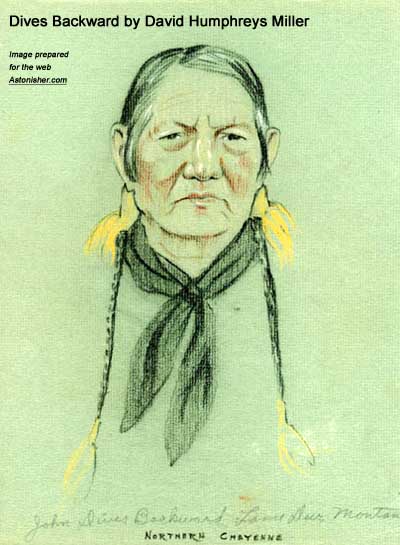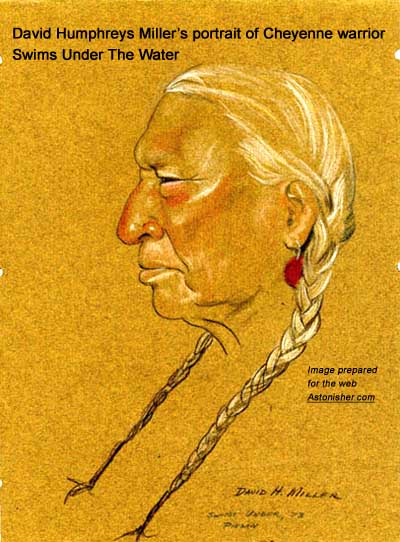|
||||||||||||
Bruce Brown's 100 Voices... Dives Backward's Story of the Battle
DIVES BACKWARD'S STORY OF THE BATTLE
Just after catching another grasshopper and starting down the bank with it, the lad heard hoofs rumble on the hard ground of the flat above. It sounded like thousands of horses thundering past. Running up the slope, Dives Backward got his first look at the enemy Arikaras, who had a distinct and unfamiliar look. One war-bonneted rider, probably Bloody Knife, caught the boy's eye. Sensing danger at once, he quickly forgot all about grasshoppers and fish, and clambered down the bank. "I saw someone wearing a war bonnet go by!" he shouted to his uncle. "They're looking for someone." White Shield and Little Chief hurried up to higher ground to look. By that time the Arikaras had all ridden past, but soldiers dressed in Army blue were visible through the haze of dust. "The camp!" cried Little Chief. "They're going to attack the camp!" White Shield agreed, and the three ran back down to the Little Big Horn. By keeping in the defile of the river, they hoped to reach the Cheyenne camp circle nearly six miles downstream. [Note: Here is White Shield's account of what happened when he got back to the village.] Custer's Fall: The Indian Side of the Story by David Humphreys Miller, University of Nebraska Press, Lincoln, NE 1957 p 84 - 85
Although not an account of the battle per se, Cheyenne youth Dives Backward's experience of the battle is nevertheless illuminating, showing us (1) the world that the battle shattered (similarly, Yellow Nose said he was swimming with Crazy Horse at the river when they heard the first shots), and (2) why White Shield didn't have a gun when he came running to the defense of the village moments before one of the other warriors at the Medicine Tail Coulee ford who did have a gun, White Cow Bull, shot an officer in buckskin on a "sorrel horse with... four white stockings" and saw him fall out of the saddle into the Little Bighorn River. White Cow Bull didn't know it at the time, but this fallen officer can only be George Custer. See Who Killed Custer -- The Eye Witness Answer for more info. * * *
Miller frequenlty made pastel sketches of the Sioux survivors of the Battle of the Little Bighorn whom he interviewed. Some of Miller's portraits are exceptionally fine evocations of the historic personalities in their own right, such as his portraits of Lazy White Bull and Old Eagle and Black Elk late in life. Click here for information of David Humphreys Miller's sources among the Sioux, Cheyenne, Crow, Arikara and Apapaho. Here is another account of the battle by Dives Backward. -- B.B.
|
||||||||||||





 Although not born into the Teton Sioux, David Humphreys Miller was adopted late in life by both
Although not born into the Teton Sioux, David Humphreys Miller was adopted late in life by both 







